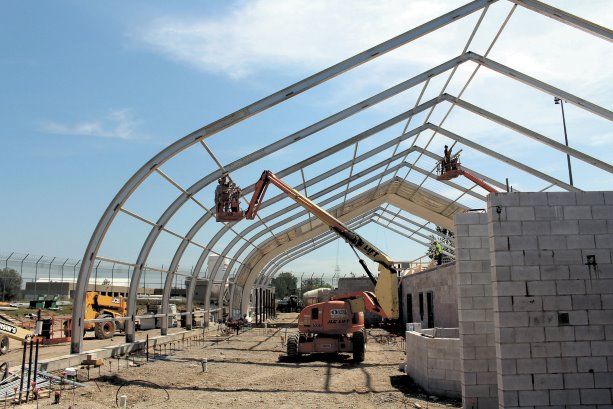Construction is nearing the home stretch on an $8.5 million regional intermittent centre in London, Ont. that incorporates a tensioned membrane structure — a first on such a facility in the province.
The 112-bed, 25,000-square-foot centre is being built by Cambridge-based Collaborative Structures Ltd. on the grounds of the province’s existing Elgin Middlesex Detention Centre.
The Ministry of Community Safety and Correctional Services said the tension membrane technology allows the centre to be designed and built within approximately 10 months.
The project is being delivered on a design-build basis by Collaborative Structures, a firm that provides construction management, project management, general contracting and design-build services in southwestern Ontario. NORR Ltd. is providing architectural and engineering services. The tension membrane component is being supplied by Sprung Structures.
Ministry spokesman Brent Ross said the decision to incorporate the tensioned membrane structure was based in part on the expedient manner in which the facility could be constructed.
Tension membrane technology uses a non-corroding aluminum substructure overlaid with architectural membrane panels placed under high tension.
The ministry said the structure will be as secure as conventional facilities and have a 30-plus year lifespan, which it said is identical to traditional construction projects.
Construction costs using this technology are generally cheaper than conventional structures, the ministry added.
This structure also provides a bright working environment.
"The tension membrane structure is currently being used effectively in British Columbia and (on) correctional systems in the United States, but is a first in Ontario," Ross said via email.
BC Corrections has been using this technology since 2008 to house sentenced offenders.
The London facility is the first such in the province to be constructed as part of a strategy to build standalone intermittent centres on the sites of existing correctional facilities to help ease capacity pressures.
The centre incorporates a variety of security and workplace safety features, among them uninterrupted sightlines for correctional staff. The building will be linked to the existing facility by a walkway.
The ministry said the interior will include the same security levels and features used at other Ontario facilities to "safely and securely" house intermittent offenders.
Ross said no significant challenges have arisen to date during construction.
"The building is on track to be constructed within the estimated 10-month period," he said.
Once major construction is completed, the ministry will commence commissioning activities — including installation of life safety and electronic security systems.
"It is anticipated that commissioning will continue until spring 2016, at which point the facility will be operational," Ross said.
An intermittent sentence is a sentence of 90 days or less that offenders serve in segments of time, typically on weekends.
Ross said the rapid construction of this type of facility will allow the ministry to move forward on the transformation of the correctional system "and make real progress in a timely manner in alleviating capacity pressures and overcrowding issues."
Ontario’s first intermittent centre, the Toronto Intermittent Centre, opened in December 2011 as part of the newly opened Toronto South Detention Centre complex.
The ministry said construction of an intermittent centre at the site of existing facilities improves operational efficiency by using staff and services associated with existing facilities.





Recent Comments
comments for this post are closed